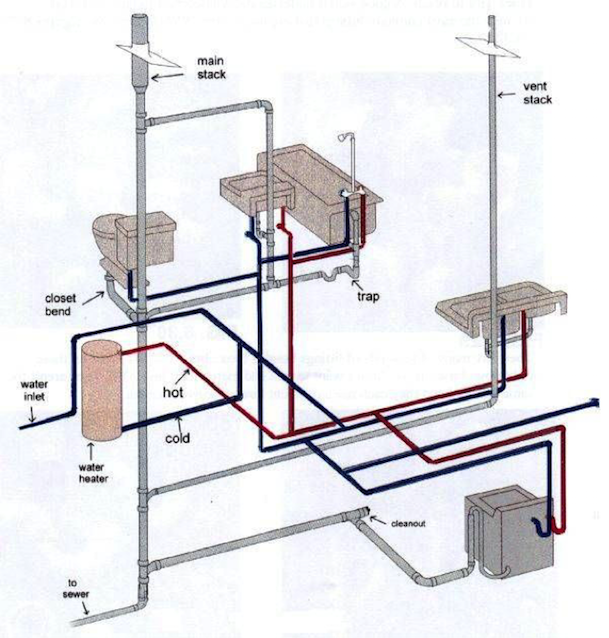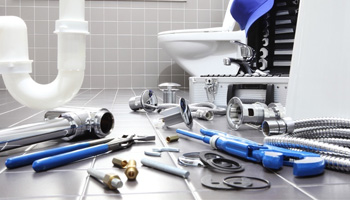Essential Components of Your House's Plumbing System
Essential Components of Your House's Plumbing System
Blog Article
We have stumbled upon this article about Exploring Your Homes Plumbing Anatomy directly below on the internet and thought it made good sense to discuss it with you over here.

Comprehending how your home's pipes system works is vital for each property owner. From delivering tidy water for alcohol consumption, food preparation, and showering to safely removing wastewater, a properly maintained pipes system is important for your household's health and comfort. In this comprehensive overview, we'll check out the intricate network that makes up your home's plumbing and deal pointers on upkeep, upgrades, and handling common concerns.
Intro
Your home's pipes system is more than just a network of pipes; it's an intricate system that guarantees you have accessibility to clean water and efficient wastewater elimination. Recognizing its elements and how they collaborate can assist you avoid costly fixings and make sure whatever runs smoothly.
Standard Parts of a Plumbing System
Pipelines and Tubing
At the heart of your plumbing system are the pipelines and tubes that bring water throughout your home. These can be made of numerous materials such as copper, PVC, or PEX, each with its benefits in terms of resilience and cost-effectiveness.
Components: Sinks, Toilets, Showers, and so on.
Fixtures like sinks, commodes, showers, and tubs are where water is made use of in your home. Understanding how these components connect to the pipes system assists in detecting issues and intending upgrades.
Shutoffs and Shut-off Points
Shutoffs regulate the flow of water in your plumbing system. Shut-off shutoffs are crucial during emergencies or when you require to make repairs, enabling you to separate parts of the system without interfering with water flow to the whole house.
Water System System
Key Water Line
The main water line links your home to the local water supply or a private well. It's where water enters your home and is distributed to different fixtures.
Water Meter and Pressure Regulator
The water meter steps your water use, while a stress regulator guarantees that water moves at a secure pressure throughout your home's plumbing system, avoiding damages to pipes and components.
Cold Water vs. Hot Water Lines
Understanding the distinction between cold water lines, which provide water directly from the major, and hot water lines, which bring heated water from the hot water heater, helps in troubleshooting and planning for upgrades.
Water drainage System
Drain Pipeline and Traps
Drain pipelines lug wastewater far from sinks, showers, and commodes to the drain or sewage-disposal tank. Catches protect against sewer gases from entering your home and likewise catch debris that could cause obstructions.
Ventilation Pipes
Ventilation pipelines enable air into the water drainage system, preventing suction that might slow down drain and trigger traps to empty. Correct air flow is crucial for keeping the stability of your pipes system.
Significance of Appropriate Water Drainage
Ensuring proper drainage avoids backups and water damages. Routinely cleaning drains pipes and keeping traps can avoid expensive repair work and extend the life of your plumbing system.
Water Heater
Kinds Of Water Heaters
Water heaters can be tankless or traditional tank-style. Tankless heating systems warmth water as needed, while containers keep heated water for immediate usage.
Exactly How Water Heaters Link to the Plumbing System
Recognizing just how hot water heater link to both the cold water supply and hot water circulation lines assists in diagnosing issues like insufficient hot water or leaks.
Maintenance Tips for Water Heaters
Consistently purging your water heater to remove sediment, checking the temperature level setups, and examining for leakages can prolong its life expectancy and improve energy efficiency.
Typical Plumbing Concerns
Leaks and Their Reasons
Leaks can happen because of aging pipes, loosened installations, or high water pressure. Resolving leaks promptly avoids water damages and mold and mildew growth.
Obstructions and Blockages
Obstructions in drains and toilets are often brought on by purging non-flushable items or an accumulation of oil and hair. Using drainpipe screens and bearing in mind what decreases your drains can prevent obstructions.
Indications of Pipes Issues to Expect
Low water stress, slow drains pipes, foul odors, or unusually high water expenses are signs of prospective pipes issues that need to be attended to promptly.
Pipes Upkeep Tips
Regular Examinations and Checks
Arrange annual pipes inspections to capture concerns early. Look for indications of leakages, corrosion, or mineral accumulation in taps and showerheads.
DIY Maintenance Tasks
Basic jobs like cleansing faucet aerators, checking for bathroom leakages making use of color tablets, or insulating subjected pipes in chilly environments can protect against significant plumbing issues.
When to Call an Expert Plumbing Professional
Know when a plumbing problem calls for specialist knowledge. Attempting complicated repair services without proper understanding can cause even more damages and greater fixing prices.
Updating Your Plumbing System
Reasons for Updating
Upgrading to water-efficient fixtures or changing old pipes can enhance water high quality, decrease water bills, and enhance the value of your home.
Modern Plumbing Technologies and Their Benefits
Check out innovations like wise leak detectors, water-saving toilets, and energy-efficient water heaters that can save cash and minimize environmental effect.
Cost Considerations and ROI
Calculate the upfront expenses versus long-lasting cost savings when thinking about plumbing upgrades. Many upgrades spend for themselves via lowered utility costs and less repair services.
Environmental Impact and Conservation
Water-Saving Components and Home Appliances
Setting up low-flow faucets, showerheads, and bathrooms can considerably decrease water usage without giving up efficiency.
Tips for Lowering Water Usage
Easy routines like fixing leaks without delay, taking shorter showers, and running full lots of washing and recipes can save water and lower your utility costs.
Eco-Friendly Pipes Options
Think about sustainable pipes products like bamboo for floor covering, which is durable and eco-friendly, or recycled glass for kitchen counters.
Emergency situation Preparedness
Steps to Take Throughout a Pipes Emergency situation
Know where your shut-off valves are located and just how to switch off the water system in case of a burst pipeline or significant leakage.
Value of Having Emergency Calls Helpful
Keep contact info for local plumbing professionals or emergency situation services conveniently available for quick action during a pipes dilemma.
DIY Emergency Situation Fixes (When Appropriate).
Short-lived repairs like making use of duct tape to spot a leaking pipeline or putting a pail under a leaking faucet can decrease damage till an expert plumber shows up.
Conclusion.
Recognizing the makeup of your home's plumbing system encourages you to maintain it successfully, saving money and time on repairs. By following routine upkeep routines and remaining informed regarding modern-day plumbing innovations, you can guarantee your plumbing system runs efficiently for many years ahead.
HOW YOUR PLUMBING SYSTEM WORKS
Which Pipes Do What?
Blue lines = fresh water supply entering the building
Red lines = hot water supply entering the building
Grey lines = pipes carrying waste away from the building and venting pipes carrying gases away from the building (through the roof)
YOUR MAIN PLUMBING SYSTEMS
There are two main plumbing systems that support your home s basic plumbing needs one that brings clean water into your home, and one that sends dirty water away from your home. Connected to the toilet, bath, shower, and other faucets in your home, these two systems keep your water flowing in the right directions.
ACCESSING FRESH WATER
Fresh and clean water is brought into your home through the main water supply line . Filtered through one pipe, this water is pressured to flow into the various fixtures in your home at any given time.
This water can be sourced from a well located on your property, a pond or river (mostly cottages), or, as in most cases, from the city s municipal water treatment centre. However, it is important to note that water that is untreated, such as the water siphoned from ponds or rivers, may not be safe to drink. Personal water supplies always need to be treated for hardness and contaminants before consumed.
MUNICIPAL WATER SUPPLIES
Improve taste and odour
Remove sediment
Eliminate hardness
Reduce chlorine
COLD WATER SUPPLY VS. HOT WATER SUPPLY
Cold water flows into your home or building through the service line, which then distributes hot or cold water to your fixtures. This line is most commonly run through a central column that runs floor to floor. Hot water runs in short and straight pipes as the longer the pipeline, the more heat that will be lost in the transfer. Having shorter pipes also allows residents to access hot water more quickly.
WASTE WATER SYSTEM
Your wastewater system is divided into two parts pipes that send wastewater away from your home and venting pipes that send sewer gas away from your home. Sewage water travels through pipes that flush the water and waste towards local sewers that are operated and managed by your city or town. Most sewer systems rely on gravity to move the wastewater to where it needs to go.
The further away from your toilet or sink, the larger wastewater pipes become. This allows for waste to be disposed of from various parts of your home or business at once without pipe blockages. The angle and flow of these pipes are also essential for keeping your waste pipes clear of build up.
https://harrisplumbing.ca/how-your-home-plumbing-system-works/

HOW YOUR PLUMBING SYSTEM WORKS
Which Pipes Do What?
YOUR MAIN PLUMBING SYSTEMS
There are two main plumbing systems that support your home s basic plumbing needs one that brings clean water into your home, and one that sends dirty water away from your home. Connected to the toilet, bath, shower, and other faucets in your home, these two systems keep your water flowing in the right directions.
ACCESSING FRESH WATER
Fresh and clean water is brought into your home through the main water supply line . Filtered through one pipe, this water is pressured to flow into the various fixtures in your home at any given time.
This water can be sourced from a well located on your property, a pond or river (mostly cottages), or, as in most cases, from the city s municipal water treatment centre. However, it is important to note that water that is untreated, such as the water siphoned from ponds or rivers, may not be safe to drink. Personal water supplies always need to be treated for hardness and contaminants before consumed.
MUNICIPAL WATER SUPPLIES
COLD WATER SUPPLY VS. HOT WATER SUPPLY
Cold water flows into your home or building through the service line, which then distributes hot or cold water to your fixtures. This line is most commonly run through a central column that runs floor to floor. Hot water runs in short and straight pipes as the longer the pipeline, the more heat that will be lost in the transfer. Having shorter pipes also allows residents to access hot water more quickly.
WASTE WATER SYSTEM
Your wastewater system is divided into two parts pipes that send wastewater away from your home and venting pipes that send sewer gas away from your home. Sewage water travels through pipes that flush the water and waste towards local sewers that are operated and managed by your city or town. Most sewer systems rely on gravity to move the wastewater to where it needs to go.
The further away from your toilet or sink, the larger wastewater pipes become. This allows for waste to be disposed of from various parts of your home or business at once without pipe blockages. The angle and flow of these pipes are also essential for keeping your waste pipes clear of build up.
https://harrisplumbing.ca/how-your-home-plumbing-system-works/
As a passionate person who reads on Exploring Your Homes Plumbing Anatomy, I imagined sharing that excerpt was a great idea. Remember to set aside a second to distribute this page if you enjoyed reading it. I treasure your readership.
Schedule Service Report this page